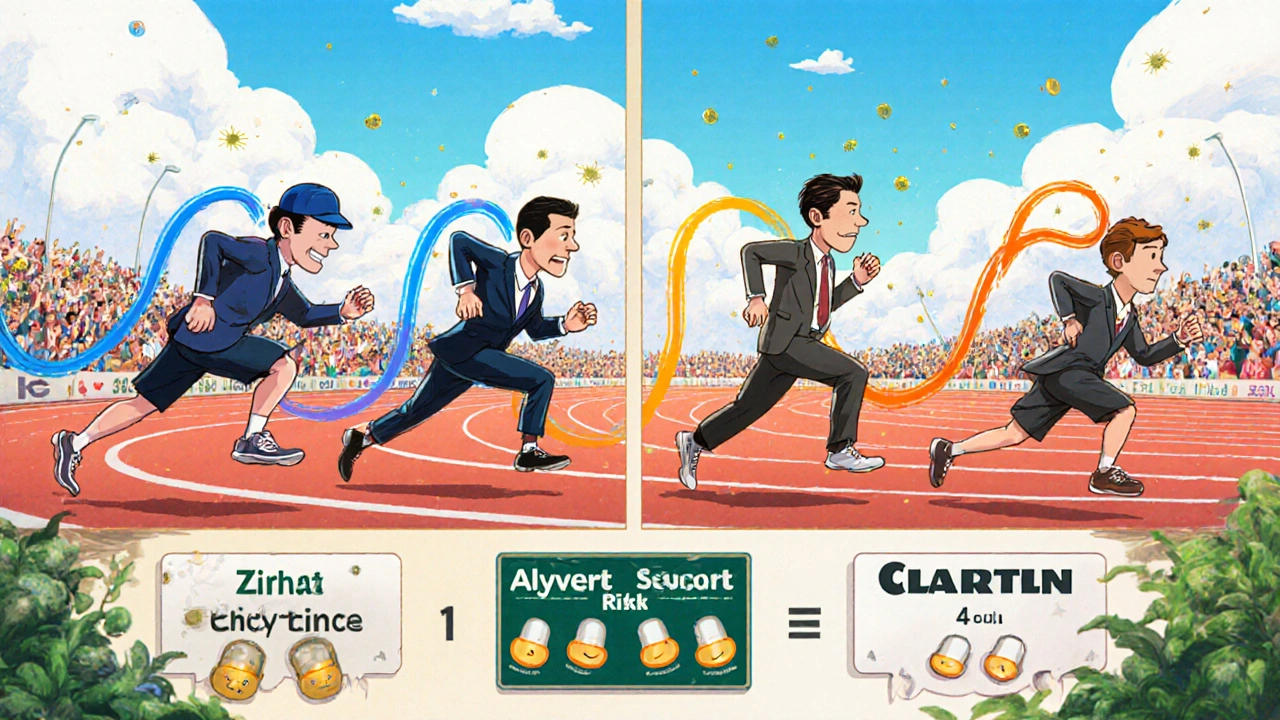Allergy Medication Selector
Find your best allergy medication match
Answer a few questions to get personalized recommendations based on your symptoms, lifestyle, and priorities.
1. How quickly do you need relief?
2. How important is being alert during the day?
3. What's your priority?
Your Best Match
Why This Works for You
Key Comparison
| Medication | Onset | Sedation | Duration | Price |
|---|
Quick Takeaways
- Alavert is a non‑sedating, once‑daily antihistamine containing loratadine.
- It works best for mild to moderate seasonal allergies with a 24‑hour duration.
- Common alternatives include Zyrtec, Claritin, Allegra, Benadryl and Xyzal, each with its own onset, sedation level, and price point.
- Choose Zyrtec or Xyzal if you need faster relief; pick Claritin for a budget‑friendly generic.
- Benadryl remains the go‑to for short‑term, sleep‑inducing relief, but it’s not ideal for daily use.
When it comes to tackling seasonal allergies, Alavert is a brand‑name, non‑sedating antihistamine that contains the active ingredient loratadine. It’s sold over‑the‑counter in the United States and promises 24‑hour relief from sneezing, runny nose, and itchy eyes. But is it really the best choice for every allergy sufferer? This guide lines up Alavert side‑by‑side with the most popular alternatives so you can see where it shines, where it falls short, and which option fits your lifestyle.
Why Alavert (Loratadine) is a Popular Choice
Loratadine belongs to the second‑generation antihistamine family, which means it blocks histamine receptors without crossing the blood‑brain barrier in significant amounts. The result is minimal drowsiness compared with first‑generation drugs like diphenhydramine. Alavert’s key attributes include:
- Onset: 1‑3 hours after ingestion.
- Duration: Roughly 24 hours, allowing once‑daily dosing.
- Side‑effect profile: Low incidence of sedation, dry mouth, or headache.
- Drug interactions: Fewer than many antihistamines, though it can interact with certain antibiotics and antifungals.
These points make Alavert a safe pick for people who need to stay alert at work or school. However, its moderate onset time and occasional price premium compared with generic loratadine can be drawbacks.
Head‑to‑Head Comparison of Top Antihistamines
| Medication | Active Ingredient | Typical Onset | Duration of Action | Sedation Risk | Average OTC Price (US) |
|---|---|---|---|---|---|
| Alavert | Loratadine 10 mg | 1-3 hours | 24 hours | Low | $12‑$15 for 30 tablets |
| Claritin | Loratadine 10 mg (generic) | 1-3 hours | 24 hours | Low | $8‑$10 for 30 tablets |
| Zyrtec | Cetirizine 10 mg | ~30 minutes | 24 hours | Moderate (some users report mild drowsiness) | $10‑$12 for 30 tablets |
| Allegra | Fexofenadine 180 mg | ~1 hour | 12 hours (twice‑daily dosing) | Very Low | $15‑$18 for 30 tablets |
| Benadryl | Diphenhydramine 25 mg | 15‑30 minutes | 4‑6 hours | High (strong drowsiness) | $5‑$8 for 100 tablets |
| Xyzal | Levocetirizine 5 mg | ~1 hour | 24 hours | Low‑Moderate | $13‑$16 for 30 tablets |
The table makes it easy to spot where Alavert stands. Its price sits between the cheapest generic loratadine (Claritin) and the premium options (Allegra, Xyzal). If you value a truly non‑sedating profile, Alavert, Claritin, and Xyzal are top picks. For rapid relief, Zyrtec or Benadryl edges ahead.

When to Choose Alavert Over the Rest
Alavert shines in specific scenarios:
- All‑day work or school: Its low sedation risk lets you stay focused.
- Moderate symptom severity: The 24‑hour duration covers typical pollen peaks without needing a second dose.
- Drug‑interaction caution: If you’re on antibiotics like erythromycin or antifungals such as ketoconazole, Alavert’s interaction profile is well‑studied.
If any of those apply, Alavert may be worth the slightly higher price tag.
Best Alternatives for Different Needs
Not everyone needs the exact same antihistamine. Here’s a quick guide based on personal priorities:
- Fastest onset: Benadryl works within 15 minutes, perfect for sudden flare‑ups, but expect drowsiness.
- Budget‑friendly: Generic Claritin (loratadine) offers the same active ingredient at a lower cost.
- Low‑sedation, rapid action: Zyrtec starts in about 30 minutes and is generally well‑tolerated, though a small fraction feel sleepy.
- Twice‑daily coverage: Allegra needs a second dose but boasts a very low sedation profile, making it a solid choice for night‑time relief.
- Premium non‑sedating: Xyzal (levocetirizine) offers a balance of quick action and minimal drowsiness, albeit at a higher price.
Safety, Side Effects, and Who Should Avoid Alavert
Even though Alavert is considered safe for most adults, keep an eye on the following:
- Pregnancy & breastfeeding: Data is limited, so consult your physician before use.
- Kidney or liver impairment: Dose adjustments may be needed; a doctor’s guidance is essential.
- Children under 6: Alavert is not approved for this age group; pediatric formulations of loratadine (e.g., a syrup) are recommended instead.
Common mild side effects-headache, dry mouth, or slight fatigue-occur in less than 5 % of users. Severe reactions like rash or swelling are rare but require immediate medical attention.

How to Pick the Right Antihistamine for You
Think of choosing an antihistamine as solving a simple decision tree:
- Do you need rapid relief? If yes, look at Benadryl or Zyrtec.
- Is day‑time alertness critical? Favor Alavert, Claritin, or Xyzal.
- Is cost the main driver? Generic Claritin or store‑brand loratadine wins.
- Do you have specific health conditions (e.g., liver disease)? Check the medication’s metabolism pathway-loratadine is processed in the liver, while fexofenadine is mainly excreted unchanged in the gut.
Answering these questions narrows the field quickly, saving you time and money.
FAQs - Your Burning Questions About Alavert and Its Alternatives
Can I take Alavert with alcohol?
Mixing alcohol with any antihistamine can increase drowsiness, even with low‑sedating drugs like Alavert. A small amount of alcohol usually isn’t harmful, but it’s safest to limit drinking while the medication is active.
How does Alavert compare to generic loratadine?
The active ingredient is identical, so efficacy and side‑effects are virtually the same. The price is the main difference-generic loratadine (often sold as Claritin) is cheaper, while Alavert may be preferred for brand loyalty or perceived quality.
Is Zyrtec more sedating than Alavert?
Zyrtec (cetirizine) has a slightly higher sedation risk-about 10‑15 % of users report mild drowsiness, compared with less than 5 % for Alavert. If you’re sensitive to any drowsiness, Alavert or Claritin are safer bets.
Can children use Alavert?
Alavert is approved for ages 12 and up. For younger kids, a pediatric loratadine syrup (often labeled as Claritin Pediatric) is the recommended form.
What should I do if I miss a dose?
Take the missed tablet as soon as you remember, unless it’s almost time for the next dose. In that case, skip the missed one-don’t double up.
Bottom Line: Is Alavert Right for You?
If you need a reliable, non‑sedating antihistamine that you can take once a day without worrying about drowsiness at work or school, Alavert is a solid pick. Its price is higher than generic loratadine, but the brand’s reputation for consistency can justify the cost for many users.
However, if you prioritize ultra‑fast onset, have a tight budget, or need a nighttime sleep aid, look at Zyrtec, Benadryl, or even the premium Xyzal. The decision ultimately hinges on how you weigh onset speed, sedation risk, price, and dosing frequency.
Use the comparison table, consider your personal needs, and you’ll land on the antihistamine that keeps pollen at bay while fitting your daily routine.

For adults seeking a non‑sedating antihistamine, loratadine’s pharmacokinetic profile supports a convenient once‑daily regimen, which aligns well with typical work schedules. The drug’s low propensity for crossing the blood‑brain barrier reduces the likelihood of drowsiness, making it suitable for tasks requiring sustained alertness. Moreover, its interaction potential is comparatively modest, though clinicians should remain vigilant when prescribing alongside certain antibiotics or antifungals. When evaluating cost‑effectiveness, the brand name Alavert carries a premium; however, the active ingredient mirrors that of generic loratadine, which is widely available at a lower price point. Patients should weigh the marginal benefit of brand consistency against the economic advantage of generics, especially when insurance coverage is a consideration. Ultimately, the decision hinges on individual tolerance, budget constraints, and the necessity for a reliable 24‑hour coverage without sedation.